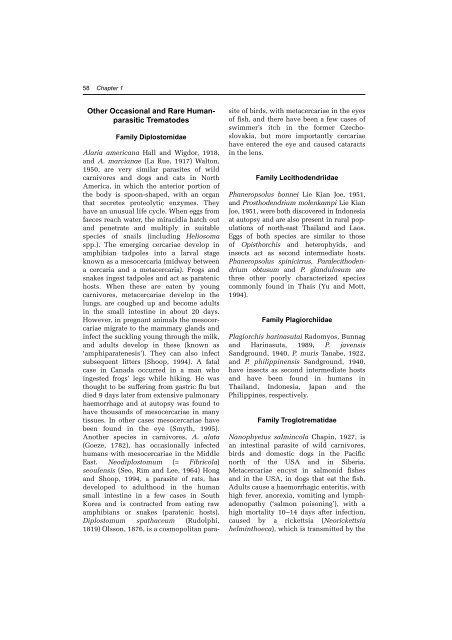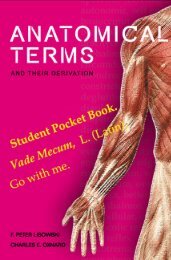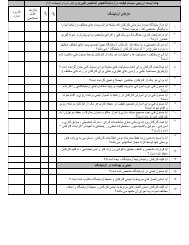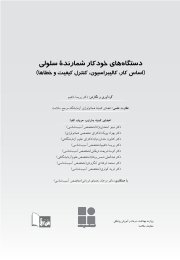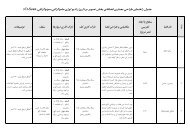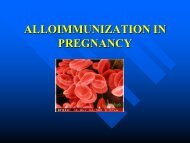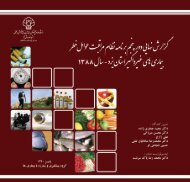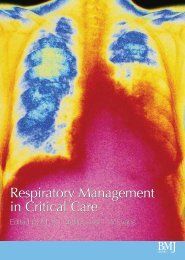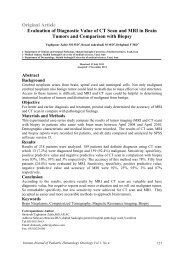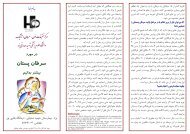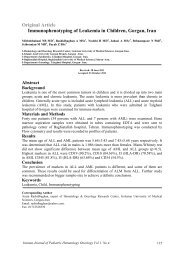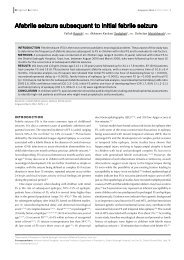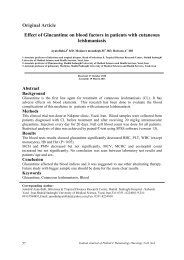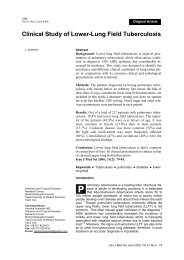Create successful ePaper yourself
Turn your PDF publications into a flip-book with our unique Google optimized e-Paper software.
58 Chapter 1<br />
Other Occasional <strong>and</strong> Rare <strong>Human</strong>parasitic<br />
Trematodes<br />
Family Diplostomidae<br />
Alaria americana Hall <strong>and</strong> Wigdor, 1918,<br />
<strong>and</strong> A. marcianae (La Rue, 1917) Walton,<br />
1950, are very similar parasites of wild<br />
carnivores <strong>and</strong> dogs <strong>and</strong> cats in North<br />
America, in which the anterior portion of<br />
the body is spoon-shaped, with an organ<br />
that secretes proteolytic enzymes. They<br />
have an unusual life cycle. When eggs from<br />
faeces reach water, the miracidia hatch out<br />
<strong>and</strong> penetrate <strong>and</strong> multiply in suitable<br />
species of snails (including Heliosoma<br />
spp.). The emerging cercariae develop in<br />
amphibian tadpoles into a larval stage<br />
known as a mesocercaria (midway between<br />
a cercaria <strong>and</strong> a metacercaria). Frogs <strong>and</strong><br />
snakes ingest tadpoles <strong>and</strong> act as paratenic<br />
hosts. When these are eaten by young<br />
carnivores, metacercariae develop in the<br />
lungs, are coughed up <strong>and</strong> become adults<br />
in the small intestine in about 20 days.<br />
However, in pregnant animals the mesocercariae<br />
migrate to the mammary gl<strong>and</strong>s <strong>and</strong><br />
infect the suckling young through the milk,<br />
<strong>and</strong> adults develop in these (known as<br />
‘amphiparatenesis’). They can also infect<br />
subsequent litters (Shoop, 1994). A fatal<br />
case in Canada occurred in a man who<br />
ingested frogs’ legs while hiking. He was<br />
thought to be suffering from gastric flu but<br />
died 9 days later from extensive pulmonary<br />
haemorrhage <strong>and</strong> at autopsy was found to<br />
have thous<strong>and</strong>s of mesocercariae in many<br />
tissues. In other cases mesocercariae have<br />
been found in the eye (Smyth, 1995).<br />
Another species in carnivores, A. alata<br />
(Goeze, 1782), has occasionally infected<br />
humans with mesocercariae in the Middle<br />
East. Neodiplostomum (= Fibricola)<br />
seoulensis (Seo, Rim <strong>and</strong> Lee, 1964) Hong<br />
<strong>and</strong> Shoop, 1994, a parasite of rats, has<br />
developed to adulthood in the human<br />
small intestine in a few cases in South<br />
Korea <strong>and</strong> is contracted from eating raw<br />
amphibians or snakes (paratenic hosts).<br />
Diplostomum spathaceum (Rudolphi,<br />
1819) Olsson, 1876, is a cosmopolitan para-<br />
site of birds, with metacercariae in the eyes<br />
of fish, <strong>and</strong> there have been a few cases of<br />
swimmer’s itch in the former Czechoslovakia,<br />
but more importantly cercariae<br />
have entered the eye <strong>and</strong> caused cataracts<br />
in the lens.<br />
Family Lecithodendriidae<br />
Phaneropsolus bonnei Lie Kian Joe, 1951,<br />
<strong>and</strong> Prosthodendrium molenkampi Lie Kian<br />
Joe, 1951, were both discovered in Indonesia<br />
at autopsy <strong>and</strong> are also present in rural populations<br />
of north-east Thail<strong>and</strong> <strong>and</strong> Laos.<br />
Eggs of both species are similar to those<br />
of Opisthorchis <strong>and</strong> heterophyids, <strong>and</strong><br />
insects act as second intermediate hosts.<br />
Phaneropsolus spinicirrus, Paralecithodendrium<br />
obtusum <strong>and</strong> P. gl<strong>and</strong>ulosum are<br />
three other poorly characterized species<br />
commonly found in Thais (Yu <strong>and</strong> Mott,<br />
1994).<br />
Family Plagiorchiidae<br />
Plagiorchis harinasutai Radomyos, Bunnag<br />
<strong>and</strong> Harinasuta, 1989, P. javensis<br />
S<strong>and</strong>ground, 1940, P. muris Tanabe, 1922,<br />
<strong>and</strong> P. philippinensis S<strong>and</strong>ground, 1940,<br />
have insects as second intermediate hosts<br />
<strong>and</strong> have been found in humans in<br />
Thail<strong>and</strong>, Indonesia, Japan <strong>and</strong> the<br />
Philippines, respectively.<br />
Family Troglotrematidae<br />
Nanophyetus salmincola Chapin, 1927, is<br />
an intestinal parasite of wild carnivores,<br />
birds <strong>and</strong> domestic dogs in the Pacific<br />
north of the USA <strong>and</strong> in Siberia.<br />
Metacercariae encyst in salmonid fishes<br />
<strong>and</strong> in the USA, in dogs that eat the fish.<br />
Adults cause a haemorrhagic enteritis, with<br />
high fever, anorexia, vomiting <strong>and</strong> lymphadenopathy<br />
(‘salmon poisoning’), with a<br />
high mortality 10–14 days after infection,<br />
caused by a rickettsia (Neorickettsia<br />
helminthoeca), which is transmitted by the


